Content
- First week of pregnancy ultrasound photo, embryo development
- Embryo at the 3rd week of development
- 4-7 weeks of pregnancy photo: embryo development
- Eighth week of pregnancy photo: fetal development
- 10 weeks pregnant: what's going on, photo
- 11-14 weeks of fetal development
- 15-18 weeks of fetal development
- 19–23 weeks of fetal development
- 24–27 weeks of fetal development: description, photo
- 28-32 weeks of fetal development: photo
- 33-37th week of fetal development
- 38–42 weeks of fetal development
The development of the fetus by week is a complex and interesting process. Today we'll walk through this process, using illustrations and descriptions of literally every week of your child's life. It is interesting for every pregnant woman to see how her baby changes over the course of 9 long months: how it grows, develops and improves.
You should start from the very beginnings of the origin of life - from the moment the egg and sperm meet, from the moment of fertilization. After all, it was then that the beginning of a new life was laid - a fertilized egg appears, from which an embryo is subsequently formed. It is the embryo that is called the fetus at the age of 8 weeks, when all the main organs and systems of the body are not formed.
So, let's consider in detail the development of the fetus by weeks with a description and a photo.
First week of pregnancy ultrasound photo, embryo development
After fertilization, there is an active crushing of the egg. Moving towards the uterus, she is freed from her shell.
The 6-8th day of pregnancy is characterized by the implantation of the egg into the wall of the uterus. The fetal egg is attached to the surface of the mucous membrane, using its villi, penetrates into it and begins to grow.
This is what happens already at 2-3 weeks of embryo development.
Embryo at the 3rd week of development
The embryo is actively developing. It separates itself from the shells. The foundations of the nervous, muscular and skeletal systems begin to form. This is a particularly important period of pregnancy.
4-7 weeks of pregnancy photo: embryo development
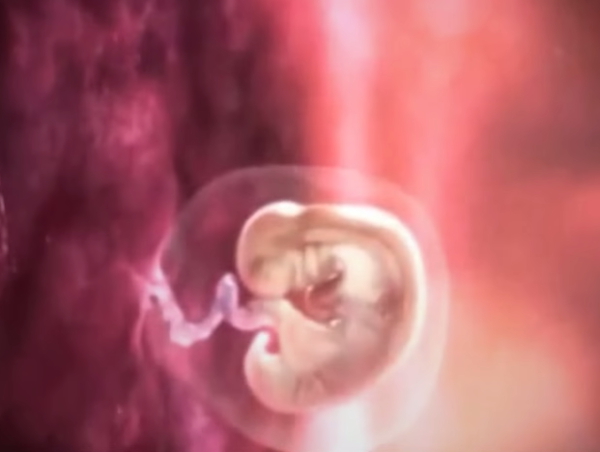 4th week of embryo development
4th week of embryo development
5th week of embryo development
At the 5th week of pregnancy, the rapid development of the embryo continues. During this period, the heart, head, limbs (handles, legs and tail) begin to form. Gill slit appears. The size of the embryo at the 5th week reaches 6 mm.
6-7 weeks of embryo development
At the 7th week of embryo development, the rudiments of the eyes, chest and abdomen begin to appear. Fingers appear on the limbs of the hands and feet. By this time, the first sense organ appeared in the embryo - the vestibular apparatus. The embryo is already growing in length up to 12 mm.
Eighth week of pregnancy photo: fetal development
From the 8th week of pregnancy, the embryo is called a fetus.
The contours of the face begin to appear, you can determine the mouth, nose and auricles. The size of the head of the fetus is correlated with the length of its entire body. The body is partially formed. Significant elements of the body have already been identified, their development continues. The fetal skeleton, its muscular and nervous systems continue to develop.
The photo shows the fetus at the 8th week of its development. The outlines of the arms and legs, the presence of fingers on the limbs are clearly traced. Sensitivity appears in the region of the mouth (the fetus is preparing for a sucking reflex). A little later, sensitivity will appear in the area of \u200b\u200bthe palms and face.
At the 9th week of pregnancy, the genitals can be observed in the fetus. Gill slits begin to die. The length of the fruit reaches 20 mm.
Marigolds appear on the limbs of the arms and legs. The first, barely noticeable, movements of the fetus occur, it tries to move. However, a pregnant woman does not yet feel this. The stethoscope allows you to hear the baby's heartbeat. The development of muscle tissues continues.
10 weeks pregnant: what's going on, photo
The whole body of the baby becomes sensitive. He studies tactile sensations, touching the walls of the umbilical cord and the fetal bladder. The child touches his body from time to time, getting new sensations.
On ultrasound, you can observe a similar picture. The child first moves away from the sensor, and then begins to touch it, putting his heels and palms to it.
Surprising is the fact that the baby feels contact with the mother through the stomach. When she puts her hand to him, the baby tries to touch her from the back.
11-14 weeks of fetal development
By the 11th week of pregnancy, the fetus has formed arms, legs, eyelids. By this time, it is possible to know the sex of the unborn child, as the genitals become distinctive.
The fetus begins to gradually swallow the amniotic fluid. And if the mother ate something bright to taste, the baby will react to it properly. For example, he sticks out his tongue in response to something bitter, grimaces and swallows less.
The skin has a transparent appearance.
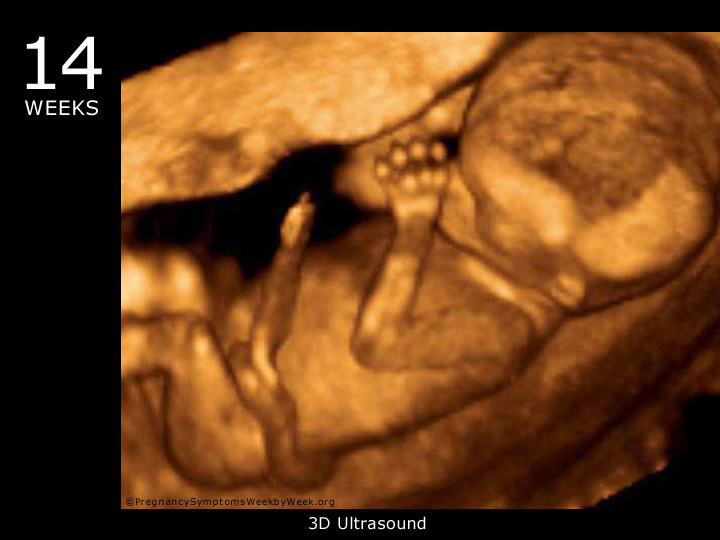 3d ultrasound, photo of the fetus
3d ultrasound, photo of the fetus
At this time, blood begins to form inside the bones. Hairs appear on the head of the fetus. The kidneys are formed, which are responsible for the production of urine in the body. The movements of the child become more coordinated.
15-18 weeks of fetal development
At week 15, the skin of the fetus acquires a pinkish tint. Ears, face and limbs are visible.
At this stage, the baby already knows how to blink, open his mouth, swallow, and make his first grasping movements. The baby begins to move more actively in the tummy of his mother. On ultrasound, you can determine the child's belonging to a particular gender.
19–23 weeks of fetal development
The child pulls his finger to his mouth, tries to suck it. The baby is very active, becomes mobile and energetic. The first pseudo-feces (meconium) appear in his intestines, the kidneys begin to function. During this time, the development of the brain takes place.
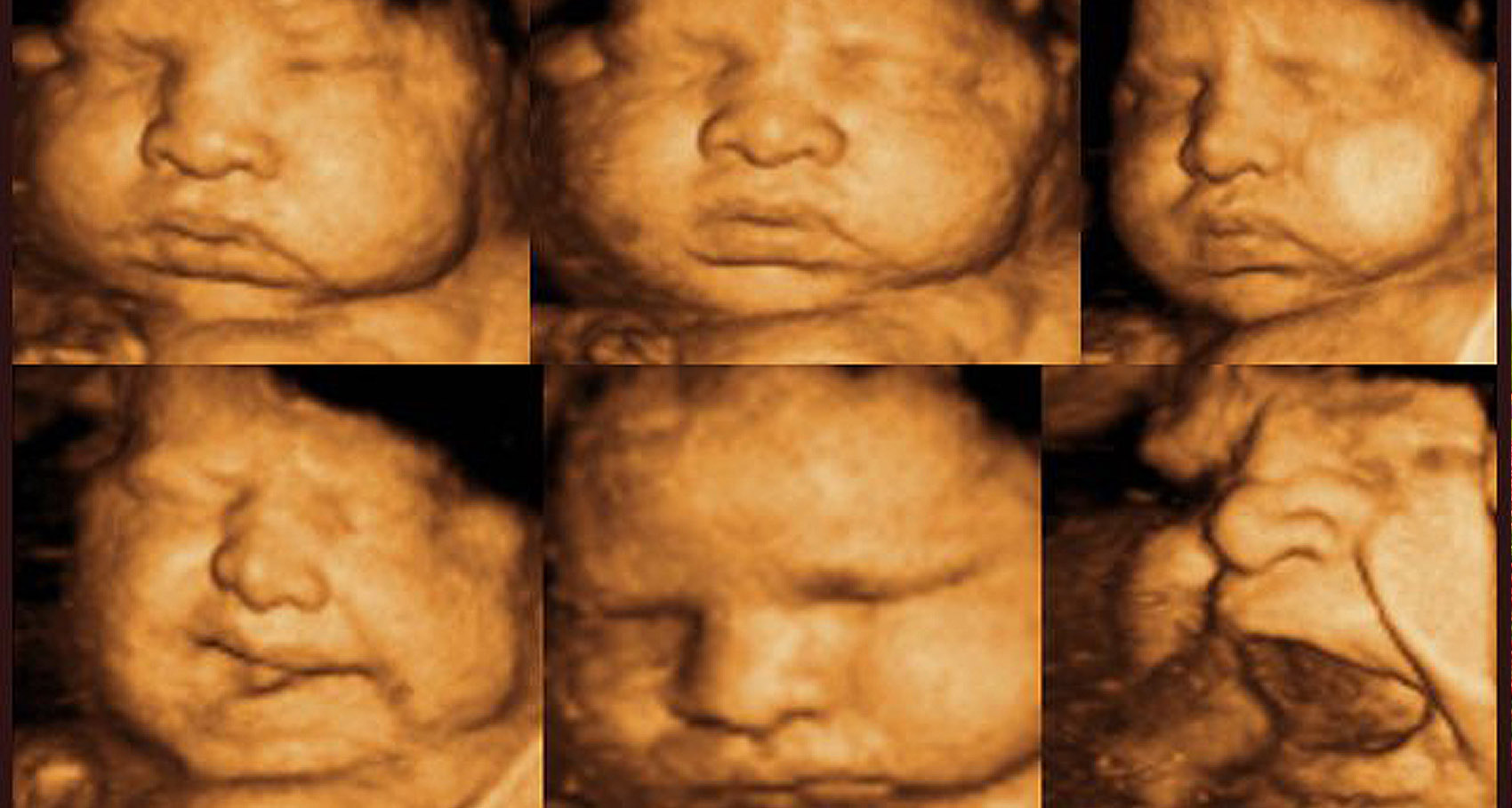 Ultrasound at 23 weeks of fetal development.
Ultrasound at 23 weeks of fetal development.
The auditory ossicles begin to ossify. Now they can conduct sound vibrations. The baby begins to hear the mother's heartbeat, her breathing and voice.
Since that time, the rapid growth of the fetus begins, it is actively gaining weight, fat deposits appear. The length of the fetus reaches 300 mm, and the weight is about 650 g.
The lungs of the child are already developed enough that the baby will be able to survive under artificial respiration in the intensive care unit.
24–27 weeks of fetal development: description, photo
The development of lung function continues. The baby begins to fall asleep and wake up. The skin begins to become covered with fluffy hairs and grease. Becomes slightly wrinkled. The cartilaginous parts in the nose and in the auricles remain soft.
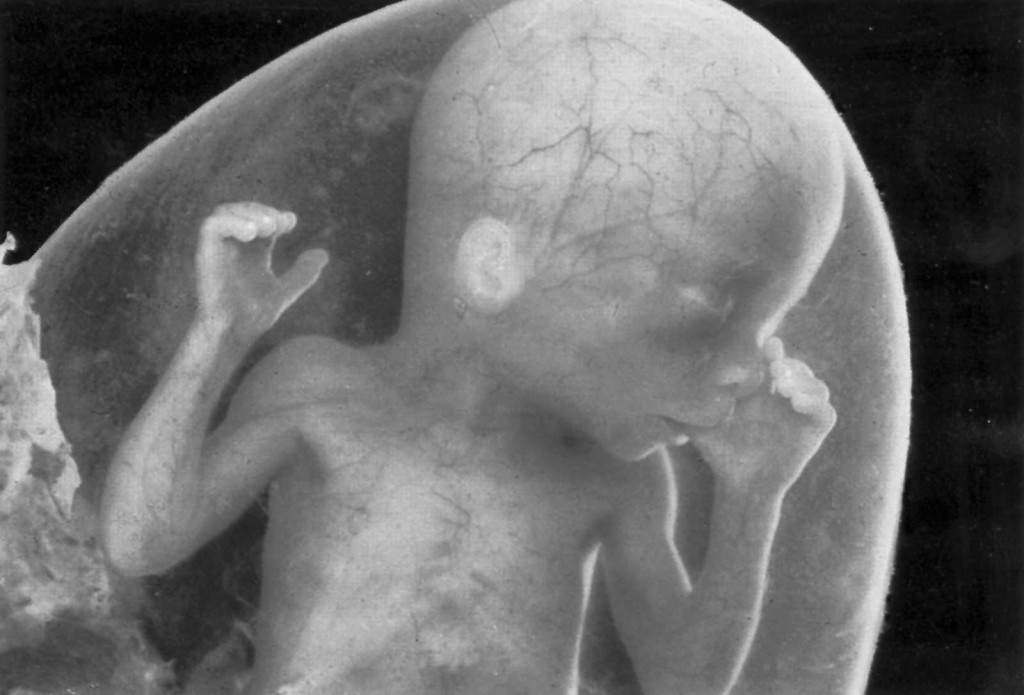 Pictured at 27 weeks pregnant
Pictured at 27 weeks pregnant
The mouth and lips become more sensitive. The eyes perceive light, the baby squints from exposure to the sun. They continue to develop, slightly open from time to time. The genital organs continue to develop: the testicles of the boys have not yet descended into the scrotum, the large labia of the girls have not yet covered the small ones. The weight of the child is from 900 to 1200 g, the length reaches 350 mm.
According to statistics, 9 out of 10 children who are born during this period survive.
28-32 weeks of fetal development: photo
The lungs of a child are already ready to process ordinary air. Breathing becomes rhythmic. Body temperature is under the control of the central nervous system. The child knows how to cry, responds to external stimuli and sounds. During sleep, the baby's eyes are closed, and open during wakefulness.
The skin became smoother, has a pinkish tint. From this moment on, the fetus grows even more actively and gains weight. Almost all babies born at this time are viable. The weight of the child is about 2500 g, and the length is about 450 mm.
33-37th week of fetal development
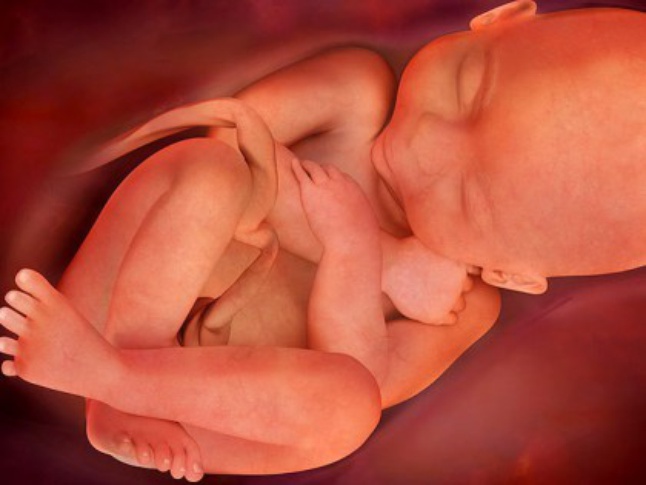 Photo 36 weeks of fetal development
Photo 36 weeks of fetal development
The baby actively reacts to light sources. The strength and tone of the muscles increase, due to which the child raises his head and turns it around. The hairs become silky instead of fluffy. The grasping reflex continues to develop and improve. The lungs have passed all stages of development and are fully ready for work.
38–42 weeks of fetal development
By this time, the fetus is considered mature and ready for birth. The child mastered more than 70 different reflexes. A subcutaneous fat layer appeared, the skin has a pale pink color. The head is covered with three-centimeter hairs.
The nails have grown and already protruded beyond the edges of the fingers. The cartilage on the nose and ears became elastic. The genital organs are finally formed: the labia majora in girls have already covered the small ones, and in boys, the testicles have descended into the scrotum.
The child recognizes the mood of the mother (joy, delight, anxiety), reacts to it with his movements. During the period of intrauterine development, the baby is so accustomed to moving in space that after birth, motion sickness and carrying in his arms is a natural state for him. This quickly soothes the baby and helps him fall asleep quickly.
The weight of the baby reaches an average of 3200-3600 g, the length is 480-520 mm.
After birth, the child does not have enough touches to his body, because at first he does not know how to touch himself, the arms and legs cannot be clearly controlled, as it was in the tummy. To make the child feel safe and comfortable, you need to take him in your arms, hug him closer to you, be always there, stroke him and talk to him.
Advice to future parents - the baby remembers the rhythm of his mother's heart. When you need to comfort him, it is enough to take him in your arms and put him on the left side, closer to the heart. The child will hear a familiar rhythm, calm down and fall asleep.
PS If you liked the article, please press the buttons of social networks.

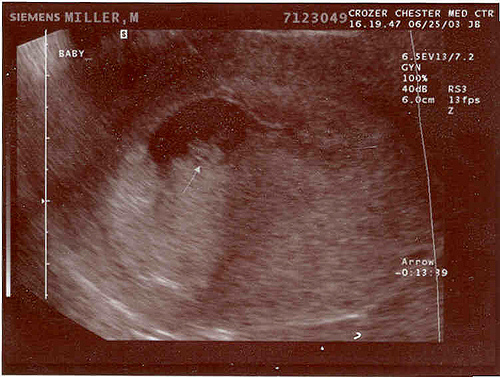 5th week of embryo development
5th week of embryo development 6-7 weeks of embryo development
6-7 weeks of embryo development
Leave a comment